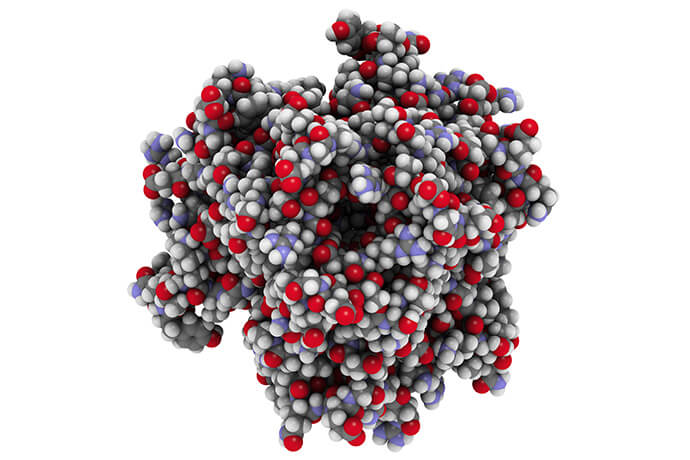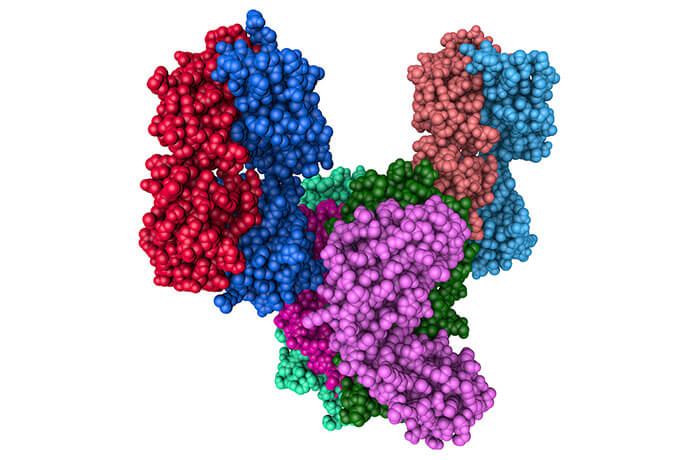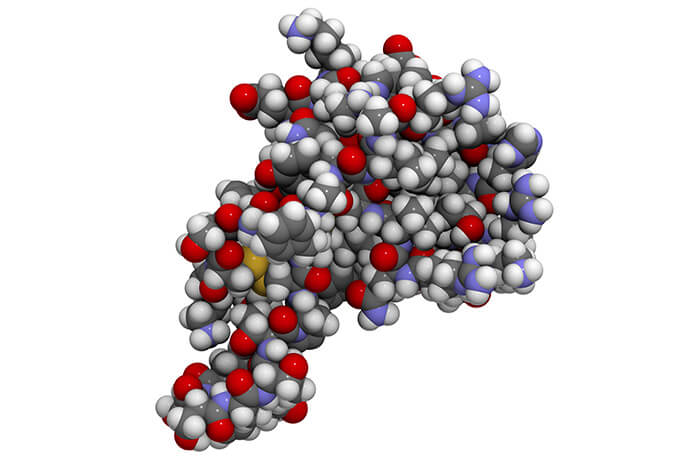Why Multiplex Analysis Has Become the New Standard
Modern immunology increasingly demands multiplex rather than single-analyte measurement. Cytokine signaling is inherently networked, and no single marker can describe an immune response in isolation.
ELISA remains the gold-standard format for specificity and transferability, but its one-analyte-per-well design now limits discovery. Each additional cytokine requires another plate, more sample, and more time—making comprehensive profiling impractical.
From Single Targets to System-Level Insight
Multiplex immunoassays such as Luminex xMAP solve this constraint. Using color-coded beads and dual-laser detection, Luminex can quantify over 100 analytes in a single 25–50 μL sample. The result is a full immune snapshot in one run instead of many individual ELISAs.
Beyond efficiency, multiplexing changes how data are interpreted: patterns of cytokine balance, pathway activation, and immune regulation emerge that single-target assays cannot reveal.
When ELISA Still Makes Sense
ELISA continues to serve well for focused validation—when only one known biomarker requires confirmation, or when a specific antibody pair is established in QC or stability programs. It remains a robust, accessible tool for narrowly defined endpoints.
The key question is therefore not which platform is superior, but which fits your study design, sample volume, and decision goal.
The next sections examine that choice through three lenses: scientific rigor, practical resource planning, and data comparability—so you can choose the method that best supports your cytokine research.
Can Luminex Reliably Replace ELISA for Biomarker Quantification?
A central question in cytokine profiling is whether multiplex assays can match ELISA's precision and reliability. Extensive cross-platform evaluations show that Luminex and ELISA correlate strongly for most cytokines, often with Pearson's r > 0.9 for well-characterized targets such as IL-6, TNF-α, and IFN-γ.
However, correlation strength varies by analyte. Cytokines like IL-12 p70 or IL-13 may display moderate or inconsistent alignment due to differences in antibody pairs, epitope recognition, or calibration standards. Transparent reporting of such exceptions—rather than hiding them—is essential for scientific credibility.
Sensitivity, Range, and LLOQ Handling
Both ELISA and Luminex offer sub-picogram detection when optimized, but their quantification ranges differ.
Luminex assays often feature a broader dynamic range, allowing detection of high and low abundance analytes within a single plate. To ensure cross-study comparability, results below the lower limit of quantification (LLOQ) are typically imputed as 0.5 × LLOQ and flagged. Performing a sensitivity analysis both with and without these imputations preserves statistical transparency and allows readers to assess robustness.
Matrix and Dilution Effects
Serum, plasma, and cell-culture matrices can produce different recovery and parallelism behaviors. These matrix effects may alter signal response curves and must be accounted for before comparing ELISA and Luminex data.
Nonlinear dilution responses are common; thus, comparisons should always be made using similar dilution factors and matching sample matrices. Recording recovery rates, spike-in controls, and parallelism data is the most practical way to document assay comparability.
Precision and Reproducibility
Well-designed Luminex assays show intra- and inter-assay coefficients of variation (CV%) comparable to ELISA. Quality control samples at low, medium, and high concentration levels should consistently pass acceptance criteria.
The most robust datasets include plate-level metadata—CV%, QC recovery, curve model (4PL or 5PL), and sample replicates—so results can be independently reviewed or reanalyzed if needed.
Table 1. Analytical comparison between ELISA and Luminex assays.
| Feature | ELISA | Luminex xMAP® | Practical Insight |
|---|---|---|---|
| Multiplexing capacity | Single analyte per well | Up to 50–100+ analytes per well | Enables full cytokine profiling in one plate |
| Assay format | Solid-phase sandwich immunoassay | Bead-based suspension array with color-coded microspheres | Luminex beads allow simultaneous detection |
| Detection system | Colorimetric or fluorescent plate reader | Dual-laser flow-based analyzer | Captures multiple fluorescent signatures per bead |
| Sample volume | Typically 100–200 µL per analyte | 25–50 µL for entire panel | Crucial for limited or pediatric samples |
| Dynamic range | Narrow to moderate | Broad range for high/low abundance | Reduces need for re-runs or multiple dilutions |
| Sensitivity (LLOQ) | Sub-pg/mL for optimized kits | Sub-pg/mL typical (analyte-dependent) | Both methods suitable for low-abundance targets |
| Precision (CV%) | ~5–10 % typical | ~5–15 % typical with QC tiers | Luminex variation acceptable if QC optimized |
| Correlation with reference ELISA | Benchmark standard | Pearson's r > 0.9 for most cytokines | Cross-validation recommended for select targets |
| Matrix compatibility | Serum/plasma validated | Serum, plasma, and cell-culture supernatants | Match matrix type for accurate comparison |
| Throughput & speed | Low; multiple plates for multiple targets | High; many analytes in one run | Saves time and reduces handling variability |
| Cost-effectiveness | Lower per analyte but scales linearly | More efficient for > 5 analytes per study | Luminex reduces total reagent and labor cost |
| Best application | Targeted validation of one/few cytokines | Broad immune profiling and discovery studies | Use Luminex for screening; ELISA for confirmation |
Sample Efficiency and Study Design
Luminex excels in low-volume or multi-timepoint studies, where sample conservation is critical. A 25–50 μL aliquot can yield a full cytokine panel, whereas a comparable ELISA study analyzing ten analytes might consume several milliliters of serum.
This efficiency makes Luminex particularly valuable for pediatric, small-animal, or biobank-limited samples, where every microliter counts.
In short: ELISA remains the benchmark for single-target precision, but Luminex enables a more data-dense, sample-efficient approach. When rigorously validated—using matched matrices, QC tiers, and transparent LLOQ reporting—Luminex delivers results that meet or exceed ELISA's analytical reliability.
 ELISA single-analyte plate assay vs Luminex bead-based multiplex immunoassay.
ELISA single-analyte plate assay vs Luminex bead-based multiplex immunoassay.
Understanding What Drives Project Investment
When planning a cytokine analysis project, total investment extends beyond the kit price. The real consideration is how sample volume, throughput, and data density interact. Each assay platform distributes these costs differently.
- ELISA scales linearly: every new analyte requires its own plate, standards, and QC controls. As target numbers grow, so do reagent consumption, plate occupancy, and incubation cycles.
- Luminex, by contrast, scales horizontally: once the multiplex panel is defined, multiple analytes are quantified simultaneously within the same well. This allows a far greater data yield per sample and per run.
For researchers working with limited sample volume, the difference becomes substantial. A single multiplex run may replace 10–20 separate ELISAs, conserving both material and time while maintaining comparable analytical precision.
Time and Throughput: The Hidden Dimension of Efficiency
Processing time directly affects project timelines. Each ELISA plate typically measures one analyte per 96 wells; analyzing ten cytokines across duplicates may occupy several full days of technician time and instrument availability.
Luminex consolidates this workflow—one plate, one incubation, one readout, yet dozens of data points. The impact on scheduling is significant: multiplex assays reduce experimental bottlenecks, improve repeatability across analytes, and simplify logistics when sample access is time-sensitive.
Scalability for Expanding Studies
Research programs rarely remain static. Once a cytokine signature is observed, follow-up studies often require adding related targets or confirming trends in larger cohorts. Luminex's modular architecture supports this evolution: panels can be expanded or customized without redesigning the entire workflow.
For ELISA-based projects, expansion means acquiring and validating new kits, reoptimizing conditions, and ensuring batch-to-batch consistency—often doubling both time and sample consumption.
Table 2. Practical resource considerations for ELISA and Luminex assays.
| Project Factor | ELISA (Single-Analyte Runs) | Luminex (Multiplex Runs) | Operational Insight |
|---|---|---|---|
| Number of analytes | Scales linearly (1 plate per analyte) | Scales horizontally (multiple analytes per plate) | Multiplexing saves both time and sample volume |
| Sample consumption | Increases with each additional target | Fixed per panel (~25–50 µL) | Essential for biobank-limited or animal samples |
| Run time | 2–3 h per plate per target | 3–4 h for entire panel | Overall time advantage expands as panel size grows |
| QC workload | Repeated for every individual assay | Shared across the entire multiplex panel | Simplifies validation and reduces technical variability |
| Instrument utilization | Multiple plate reader sessions | Single Luminex run for many targets | Improves scheduling and reduces operator fatigue |
| Panel flexibility | New targets require new kits and re-validation | Modular design supports easy panel expansion | Ideal for growing discovery studies and follow-ups |
| Data density | Limited (one endpoint per well) | Dozens of data points per sample in one readout | Maximizes information yield per experiment |
| Cost structure | Lower per-test cost but scales linearly with targets | Higher initial setup but more efficient for > 5 analytes | Luminex reduces total cost in multi-analyte studies |
| Ideal use case | Confirmatory testing or QC validation | High-throughput screening and discovery profiling | Combine both for hybrid validation workflows |
Balancing Cost, Depth, and Confidence
From a planning standpoint, Luminex represents an upfront investment in depth, while ELISA remains an incremental investment in precision. If the goal is broad immune profiling or hypothesis generation, multiplexing provides the best ratio of information to input.
If the goal is confirmatory validation of a single, well-defined cytokine, ELISA remains a sensible choice. Many high-performing laboratories use both—Luminex for discovery and pattern recognition, ELISA for targeted verification.
Choosing the Right Platform for Your Cytokine Study
When Luminex Is the Strategic Choice
Luminex is most effective when your goal is exploration or systems-level understanding. If you are mapping immune pathways, screening multiple cytokines, or working with limited-volume samples, multiplex analysis yields the broadest insight per run.
Common use cases include:
- Discovery studies seeking pathway-level changes across many cytokines.
- Small or irreplaceable samples, such as pediatric, animal-model, or biobank material.
- Longitudinal or multi-tissue studies, where consistent measurement across timepoints or compartments is essential.
- High-throughput environments, where consolidating multiple ELISAs into a single readout improves reproducibility and turnaround time.
In these contexts, Luminex offers clear logistical and interpretive advantages—capturing complex cytokine interactions that single-target assays would miss.
When ELISA Remains the Preferred Option
ELISA continues to provide unmatched reliability for focused, hypothesis-driven validation. If your project requires confirming one or two predefined cytokines—or if established SOPs already specify a particular antibody pair—ELISA is the straightforward choice. Its simplicity and traceable performance make it ideal for:
- QC and stability programs with strict comparability requirements.
- Single-target confirmation after an initial multiplex screening.
- Projects with limited assay infrastructure, where dedicated ELISA readers are readily available.
In short, ELISA ensures confidence when precision for a single analyte outweighs the need for breadth.
A Hybrid Workflow for the Best of Both Worlds
Many research teams combine both platforms strategically. Luminex for discovery, ELISA for verification is a proven workflow:
1. Use Luminex to profile broad cytokine patterns, identify clusters or co-regulated molecules.
2. Select key biomarkers from those findings.
3. Validate those targets with ELISA for precise quantification or longitudinal tracking.
This sequential approach maximizes data density while retaining the rigor of single-target confirmation. It also aligns with publication and regulatory expectations for orthogonal validation.
Table 3. Choosing between ELISA and Luminex based on research goals.
| Research Scenario | Recommended Platform | Rationale |
|---|---|---|
| Single known cytokine validation | ELISA | Established antibody pair, clear reference range |
| High-dimensional immune profiling | Luminex | Multiplex coverage of 10–100+ cytokines |
| Limited sample volume or rare material | Luminex | Minimal input, maximum data yield |
| Regulatory or QC testing | ELISA | Traceable and standardized workflow |
| Exploratory discovery study | Luminex | Broad, hypothesis-generating insight |
| Orthogonal confirmation after screening | ELISA | Robust single-target quantification |
Platform Selection in One Sentence
If you need breadth, efficiency, and discovery power → choose Luminex.
If you need focus, continuity, and standardization → choose ELISA.
Either way, clarity in experimental design—number of analytes, available volume, desired confidence level—should drive the decision, not habit or convenience.
Selecting between Luminex and ELISA is ultimately a matter of research design, not preference. Luminex provides the breadth and efficiency required for discovery, systems biology, and low-volume studies; ELISA offers the focus and traceability essential for validation and QC. Together, they form a complementary workflow that turns broad immunoprofiling into confident, quantitative insight.
Creative Proteomics supports both Luminex-based multiplex cytokine panels and custom ELISA assay development, enabling seamless transitions from exploration to validation. Our specialists can assist in optimizing your study design, panel selection, and data interpretation—ensuring every dataset meets the standards of reproducibility and scientific transparency.
References:
- Rountree, W., Bao, H., Bothra, A., et al. "Sources of variability in Luminex bead-based cytokine assays: Evidence from twelve years of multi-site proficiency testing." Journal of Immunological Methods 531 (2024): 113699.
- Platchek, M., Lu, Q., Tran, H., Xie, W. "Comparative Analysis of Multiple Immunoassays for Cytokine Profiling in Drug Discovery." SLAS Discovery 25(10) (2020): 1197–1213.
- Mountjoy, K. G. "ELISA versus LUMINEX assay for measuring mouse metabolic hormones and cytokines: sharing the lessons I have learned." Journal of Immunoassay and Immunochemistry 42(2) (2021): 154–173.
- Günther, A., et al. "Comparison of Bead-Based Fluorescence Versus Planar Electrochemiluminescence Multiplex Immunoassay Platforms for Cytokine Assessment." Frontiers in Immunology 11 (2020): 572634.
Related Services






